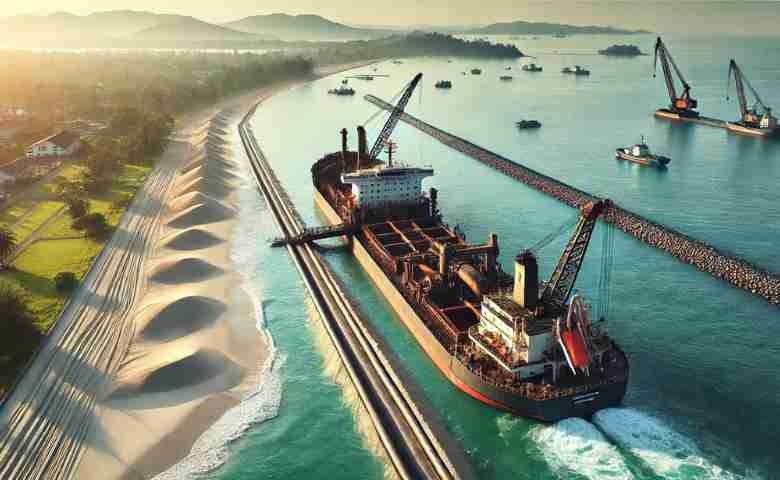Last Updated on July 30, 2024 by Admin
A typical part of projects that aim to develop and protect coastal areas, dredging involves the removal of sediments, debris, and other materials from the bottom of bodies of water. This process is undertaken for various purposes, such as constructing underwater foundations, reclaiming land, and increasing the depth of waterways to ensure safe navigation. Aside from coastal areas, dredging can also be done in rivers, lakes, and oceans.
In many ways, dredging plays a role in realising significant benefits that support both economic and environmental objectives in these places.
Table of Contents
How Is Dredging Carried Out?
Dredging is a crucial process that is executed using specialised equipment known as dredgers. The choice of dredger depends on the specific requirements of the dredging project.
Practice 15+ AI-generated technical and HR interview questions for Civil, BIM, QS, Planning, HSE and Construction roles. Get instant feedback, improved answers, a 7-day improvement plan, and a full PDF report. Designed exclusively for construction professionals.
One free full interview session included. No credit card required.
One option are cutter suction dredgers (CSDs). These use a rotating cutter head to loosen the material at the bottom of the water body, which makes them particularly effective for hard materials like compacted sand, gravel, and clay. The loosened material is then sucked up by a pump and transported through a pipeline to a designated disposal site. If the dredge material needs to be transported over a long distance or if the water in the site varies in depth, pipe floats may be used to keep the pipelines buoyant and prevent them from drifting.
Trailing suction hopper dredgers (TSHDs), meanwhile, are more preferable for large-scale projects. These have long suction pipes with drag heads that trail along the seabed, sucking up sediment into a hopper onboard the dredger. Once the hopper is full, the dredger travels to the disposal site to release the material.
A fairly versatile choice, bucket dredgers are effective for removing compacted materials and can operate in a wide range of water depths. These use a series of buckets mounted on a rotating chain to scoop up material from the bottom. The material is then transported to the surface and either placed on barges or directly to the shore. Finally, there are hydraulic dredgers that use water jets to loosen the material, which is then sucked up by a pump. These dredgers are typically used for dredging soft materials like sand or silt and are capable of operating in both shallow and deep water.
What Role Does Dredging Play in Coastal Development and Protection?
Dredging is crucial to coastal projects that aim to do the following:
Maintenance and Improvement of Navigation Channels
Safe and navigable waterways are vital for the smooth operation of maritime activities. By removing accumulated sediments, dredging ensures safe passage for ships for both trade and transportation. In fact, dredging projects are regularly undertaken to keep major shipping lanes open and to accommodate larger vessels. This supports global trade and local economies by reducing interruptions, preventing accidents, and facilitating efficient transport.
ReclaimingLand for Development
Dredging is instrumental in creating new land by removing sediment from one area and depositing it in another. This process is known as land reclamation and is used to expand coastlines, create islands, and fill in wetlands. Reclaimed land is often utilised for urban development, agriculture, and recreational purposes, such as for the creation of new waterfront developments and the expansion of port facilities, which then provide additional space for infrastructure and economic activities.
Protecting Coastal Areas
The material collected from dredging activities can be used to build up beaches and shorelines, providing an effective buffer against erosion and storm surges. This then helps protect coastal infrastructure and properties from the damaging effects of natural forces. Projects aimed at beach nourishment and the construction of seawalls and breakwaters also often rely on dredged materials. These efforts enhance the resilience of coastal areas, ensuring that communities and ecosystems are safeguarded against the increasing frequency and intensity of storms.
Remediating Environmental Damage
Dredging can also be conducted to improve water quality and restore habitats for aquatic life. Projects that involve environmental dredging aim to remove toxic substances, such as heavy metals and chemicals, that have accumulated at the bottom of water bodies. This process is vital for addressing pollution in rivers, lakes, and estuaries, as well as for reviving ecosystems, promoting biodiversity, and enhancing the health of marine and freshwater environments.
Constructing Structures On, Over, or Under Water
The construction of underwater pipelines, tunnels, and bridges typically requires dredging. Removing sediments and debris helps prepare the seabed for construction activities and ensures the stability of the structures that will be built in the area. Major infrastructure projects, such as the installation of offshore wind farms and underwater cables, also depend on dredging to create suitable foundations. These developments ultimately contribute to the growth of renewable energy sources and the expansion of communication networks.
The protection and development of coastal areas are of paramount importance for both economic and environmental reasons, and dredging plays a fundamental role in these efforts. Through careful management and sustainable practices, dredging will continue to be a vital tool in the stewardship of coastal environments and in ensuring prosperity for future generations.


